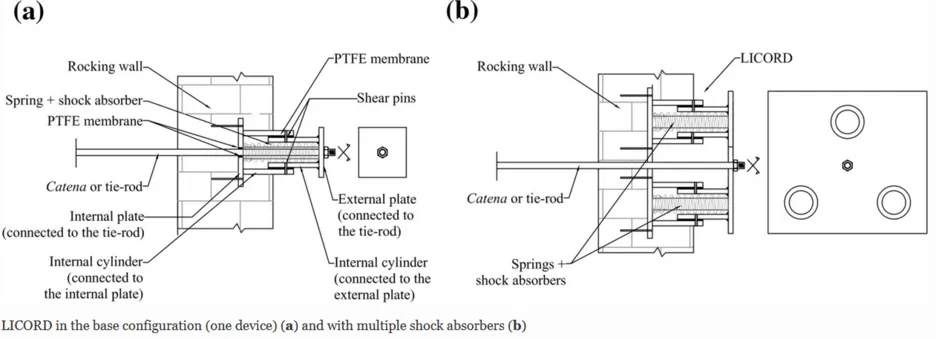- Experimental estimation of energy dissipation in rocking masonry walls restrained by an innovative seismic dissipator (LICORD). Bulletin of Earthquake Engineering 19 (5), 2021, 2265-2289 mehr… BibTeX Volltext ( DOI )
- Influence of stiffness and damping parameters of passive seismic control devices in one-sided rocking of masonry walls. Journal of Structural Engineering (ASCE) (19), 2021, 2265–2289 mehr… BibTeX Volltext ( DOI ) Volltext (mediaTUM)
- Experimental pull-out tests and design indications for strength anchors installed in masonry walls. Materials and Structures 53 (4), 2020 mehr… BibTeX Volltext ( DOI )
- Damped masonry walls in rocking motion under seismic actions. 16. D-A-CH Tagung 2019 Erdbebeningenieurwesen & Baudynamik, 2019 mehr… BibTeX
- Stochastic assessment of rocking masonry façades under real seismic records. COMPDYN 2019, 2019 mehr… BibTeX Volltext (mediaTUM)
- Modelling the Dynamic Soil-Structure Interaction for the Rocking of Rigid Façades. 16. D-A-CH Tagung - Erdbebeningenieurwesen & Baudynamik, 2019 mehr… BibTeX Volltext (mediaTUM)
Structural Vibration Control Systems
An anti-seismic device for controlling the out-of-plane rocking motion of masonry walls
Nowadays, the proper design of civil engineering structures under earthquake type actions is required to ensure the mitigation of seismic risk, especially of historic masonry buildings, whose economical value cannot be compensated for. The current design philosophy in seismic assessment of structures admits a certain level of damages of structures under low or higher intensity quakes. This implies a disruption in the operation of the structure, high repair costs with techniques often not decisive and indirect costs due to non-use. In parallel to this design philosophy, a new one seems to catch on: the DAD (Damage Avoidance Design), which foresees a low damage level due to controlled dynamic modes that reduce the negative effects of seismic excitation. This design philosophy, rarely applied, can be based both on the use of dissipative devices constituted by spring and dampers at the base of the structure and on specific structural components assembly procedures that allow for adaptive variations of structural schemes in other positions. More in detail, existing – especially historic - masonry buildings are particularly prone to earthquakes when walls - or walls and floors - are improperly connected. This could easily cause out-of-plane (OOP) modes of structural parts behaving as rigid blocks. Such OOP modes involve an extremely high risk for the structure itself, impeding a proper structural response that would require a box type behaviour, and jeopardizing human life and adjacent structures.
This project focused on the analytical and numerical study of specific devices for masonry façades able to strongly limit the damages due to OOP modes. This study was also supported by experimental tests capable of showing the actual effectiveness of these devices. The device, already covered by a patent, was tested in Italy with a preliminary experimental campaign to understand the technical specifications needed for common masonry façades. The device, called LICORD (LInear COntrolled Rocking Device), is an auto-centering damper device installed at the extremities of steel tie rods, commonly used in strengthening masonry façades. The innovative character of the device is related to the coupling of traditional techniques – such as tie rods used for centuries in improving the masonry buildings behaviour – with modern approaches tending to dissipate energy coming from earthquakes in a smart manner.
The project was developed in the following phases:
- Development of analytical approaches to include the proposed dissipative device (or any other device with similar characteristics) in numerical analysis;
- Numerical analyses to define pilot values of spring elastic stiffness and damping coefficient of the dissipator;
- Design of experimental tests, based on the numerical analysis, to validate the analytical approaches and create a prototype.
Ultimately, the project aimed at quantitatively assessing the mitigation of seismic risk associated to masonry façades strengthened by the developed devices.
Sketch of the innovative seismic dissipator (LICORD) for energy dissipation in rocking masonry walls

Comparison between the seismic response of a free and restrained damped masonry wall. With the damping device the wall is prevented from overturning.
Acknowledgment
We wish to thank the TUM (Technische Universität München) University Foundation Fellowship that financed this research activity.
